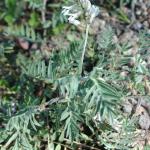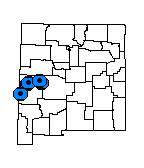Description
Plants perennial; pubescence gray-villous, villosulous, or subtomentose, the longer hairs basifixed, the shorter dolabriform; stems prostrate, divaricately branched, 1-5.5 dm long; stipules near base of stem 2.5-8 mm long, fully encircling the stem; leaves 1-5 cm long, with 11-15 narrowly lanceolate to ovate, usually acute leaflets 2-14 mm long; racemes 3-15-flowered, the axis 1-3 cm long in fruit; petals white, or whitish and faintly pink-tinged, banner 7-9.2 mm long, wings slightly shorter than banner, keel 5.1-6.2 mm long, the blade half-ovate and incurved about 90 degrees to the sharply deltoid apex; pods usually lying on ground at maturity, sessile, 1-celled, 8-10 mm long, thinly papery, strigulose-villosulous, lunately half-ellipsoid, incurved through 1/4-1/2 circle, laterally compressed and obscurely 3-sided, low-convex or shallowly grooved dorsally in lower half, carinate ventrally by the suture, cuspidate at apex; ovules 6-9.
Similar Species
Astragalus humistratus differs from other astragali in the region by its prostrate, forking stems, large connate stipules at the base of the stems, and its sessile, unilocular pods. The var. crispulus differs from other varieties of the species by its short pod of 1 cm or less and particularly the fine curly hairs that are both basifixed and dolabriform.
Distribution
New Mexico, Catron County; Arizona, Apache County.
Habitat
In sandy soils of volcanic origin on slopes, benches, and ledges in xeric pine forest; 2,100-2,485 m (7,250-8,150 ft).
Conservation Considerations
There are no known threats to this species. In addition to its natural habitat, it occurs on road banks that are open but well vegetated.
Important Literature
Barneby, R.C. 1964. Atlas of North American Astragalus. Memoirs of the New York Botanical Garden 13:1-1188.
Isely, D. 1998. Native and naturalized Leguminosae (Fabaceae) of the United States (exclusive of Alaska and Hawaii). Monte L. Bean Life Science Museum, Brigham Young University, Provo, Utah.
*Barneby, R.C. 1944. Pugillus astragalorum III. Leaflets of Western Botany 4:49-63. (A. humistratus var. crispulus appears on pp. 53-54, figs. 24-26).




